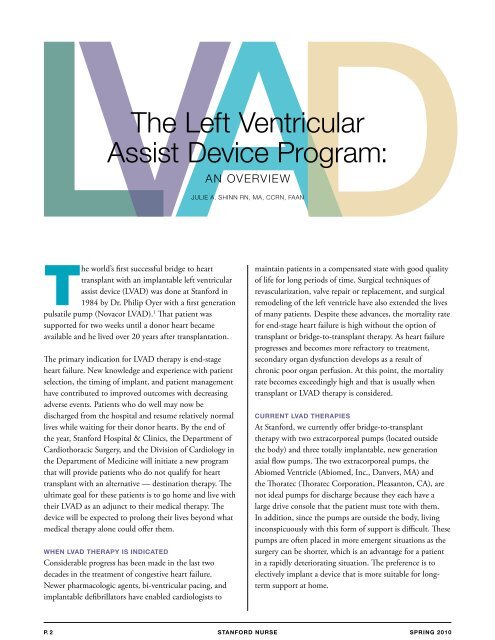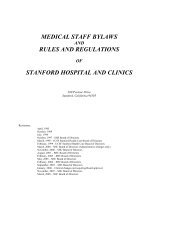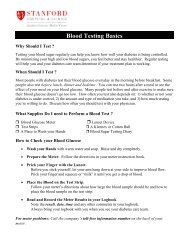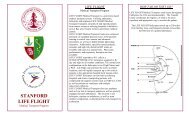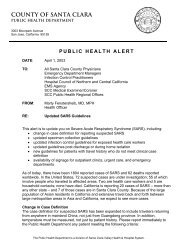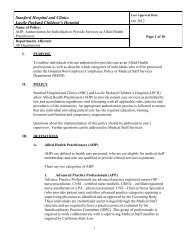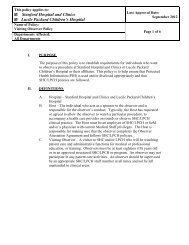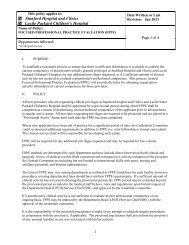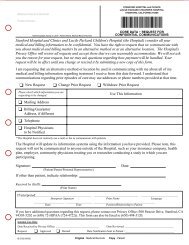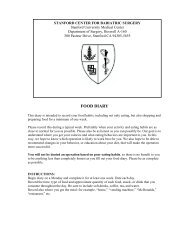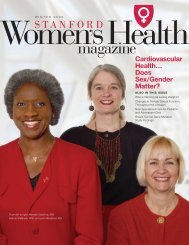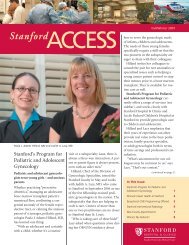SpRiNG 2010 - Stanford Hospital & Clinics
SpRiNG 2010 - Stanford Hospital & Clinics
SpRiNG 2010 - Stanford Hospital & Clinics
Create successful ePaper yourself
Turn your PDF publications into a flip-book with our unique Google optimized e-Paper software.
LVAD<br />
The Left Ventricular<br />
assist Device Program:<br />
The world’s first successful bridge to heart<br />
transplant with an implantable left ventricular<br />
assist device (LVAD) was done at <strong>Stanford</strong> in<br />
1984 by Dr. Philip Oyer with a first generation<br />
pulsatile pump (Novacor LVAD). 1 That patient was<br />
supported for two weeks until a donor heart became<br />
available and he lived over 20 years after transplantation.<br />
The primary indication for LVAD therapy is end-stage<br />
heart failure. New knowledge and experience with patient<br />
selection, the timing of implant, and patient management<br />
have contributed to improved outcomes with decreasing<br />
adverse events. Patients who do well may now be<br />
discharged from the hospital and resume relatively normal<br />
lives while waiting for their donor hearts. By the end of<br />
the year, <strong>Stanford</strong> <strong>Hospital</strong> & <strong>Clinics</strong>, the Department of<br />
Cardiothoracic Surgery, and the Division of Cardiology in<br />
the Department of Medicine will initiate a new program<br />
that will provide patients who do not qualify for heart<br />
transplant with an alternative — destination therapy. The<br />
ultimate goal for these patients is to go home and live with<br />
their LVAD as an adjunct to their medical therapy. The<br />
device will be expected to prolong their lives beyond what<br />
medical therapy alone could offer them.<br />
WhEN lvAD ThERApy iS iNDicATED<br />
Considerable progress has been made in the last two<br />
decades in the treatment of congestive heart failure.<br />
Newer pharmacologic agents, bi-ventricular pacing, and<br />
implantable defibrillators have enabled cardiologists to<br />
an OVerVIeW<br />
JULIe a. sHInn rn, Ma, CCrn, faan<br />
maintain patients in a compensated state with good quality<br />
of life for long periods of time. Surgical techniques of<br />
revascularization, valve repair or replacement, and surgical<br />
remodeling of the left ventricle have also extended the lives<br />
of many patients. Despite these advances, the mortality rate<br />
for end-stage heart failure is high without the option of<br />
transplant or bridge-to-transplant therapy. As heart failure<br />
progresses and becomes more refractory to treatment,<br />
secondary organ dysfunction develops as a result of<br />
chronic poor organ perfusion. At this point, the mortality<br />
rate becomes exceedingly high and that is usually when<br />
transplant or LVAD therapy is considered.<br />
cURRENT lvAD ThERApiES<br />
At <strong>Stanford</strong>, we currently offer bridge-to-transplant<br />
therapy with two extracorporeal pumps (located outside<br />
the body) and three totally implantable, new generation<br />
axial flow pumps. The two extracorporeal pumps, the<br />
Abiomed Ventricle (Abiomed, Inc., Danvers, MA) and<br />
the Thoratec (Thoratec Corporation, Pleasanton, CA), are<br />
not ideal pumps for discharge because they each have a<br />
large drive console that the patient must tote with them.<br />
In addition, since the pumps are outside the body, living<br />
inconspicuously with this form of support is difficult. These<br />
pumps are often placed in more emergent situations as the<br />
surgery can be shorter, which is an advantage for a patient<br />
in a rapidly deteriorating situation. The preference is to<br />
electively implant a device that is more suitable for longterm<br />
support at home.<br />
p. 2 STANFORD NURSE<br />
<strong>SpRiNG</strong> <strong>2010</strong>


